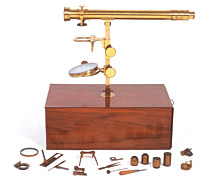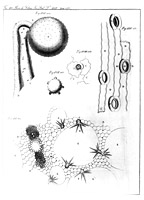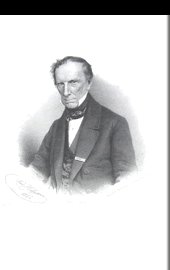A biography of Giovanni Battista Amici
1817-1823 - Catadioptric Microscope, first observations on the Chara and the discovery of the pollen tube -  return to index
return to index
 Amici had conceived of his catadioptric microscope as the reverse application of a Newtonian telescope, guided by the idea that “a microscope can be made from a telescope of any form by simply placing the object where the eye is usually placed on the telescope and transporting the eyepiece to the place where the object usually is in the telescope” (G.B. Donati). This type of microscope was improved in the years immediately following its invention, and it met universal appreciation. John Quekett wrote, e.g., in his Practical treatise on the use of the microscope (1848): “a new and most important æra in microscopic science commenced in this country [England] with the improvement in the reflecting microscope, constructed by Amici in 1815”.
Amici had conceived of his catadioptric microscope as the reverse application of a Newtonian telescope, guided by the idea that “a microscope can be made from a telescope of any form by simply placing the object where the eye is usually placed on the telescope and transporting the eyepiece to the place where the object usually is in the telescope” (G.B. Donati). This type of microscope was improved in the years immediately following its invention, and it met universal appreciation. John Quekett wrote, e.g., in his Practical treatise on the use of the microscope (1848): “a new and most important æra in microscopic science commenced in this country [England] with the improvement in the reflecting microscope, constructed by Amici in 1815”.
In 1818 Amici presented his paper De’ microscopj catadiottrici (On Catadioptric Microscopes) and Osservazioni sulla circolazione del succhio nella Chara (Observations on the Circulation of Sap in the Chara) to the Italian Society of Sciences. Both were published in the “Memorie di Matematica e di Fisica”, Volume XVIII-1820. In 1819 Amici’s paper Sopra le camere lucide (About the Camera Lucida) appeared in the “Opuscoli scientifici” of Bologna.
 His catadioptric microscope consisted in a concave elliptical reflecting mirror with an aperture of about one inch and a focal length (first focus) of two inches. Along the axis of this mirror, at about half its focal length, he placed a cylindrical segment plane mirror at 45° to the axis of the instrument, like in a Newtonian telescope (G. Dragoni). Hugo von Mohl wrote, in 1863, that “this microscope provided sharp images and magnifying power far beyond any of the other microscopes which were available then, and it would have been much more useful for Science had it been better known by more people and had it been invented in a period in which willingness and ability in microscopic research were not so rare”.
His catadioptric microscope consisted in a concave elliptical reflecting mirror with an aperture of about one inch and a focal length (first focus) of two inches. Along the axis of this mirror, at about half its focal length, he placed a cylindrical segment plane mirror at 45° to the axis of the instrument, like in a Newtonian telescope (G. Dragoni). Hugo von Mohl wrote, in 1863, that “this microscope provided sharp images and magnifying power far beyond any of the other microscopes which were available then, and it would have been much more useful for Science had it been better known by more people and had it been invented in a period in which willingness and ability in microscopic research were not so rare”.
Amici immediately applied his instrument to the study of the circulation of sap in the Chara. The main matters that he clarified were “the dependence of this circulation on the series of chlorophyll grains, that the sap flows faster in the cell wall than in the internal cell space, that there is no dividing wall between the rising current and the descending current of sap and the possibility of dividing the sap current into two separate circuits by constricting the cell” (H. von Mohl).
 In 1822 Amici presented his Osservazioni microscopiche sopra varie piante (Microscopic observations about various plants) to the Italian Society of Sciences (“Memorie di Matematica e di Fisica”, Tomo XIX-1823), in which he announced the discovery of the pollen tube, or gut. This first observation about fertilization was as historically important as it was accidental.
In 1822 Amici presented his Osservazioni microscopiche sopra varie piante (Microscopic observations about various plants) to the Italian Society of Sciences (“Memorie di Matematica e di Fisica”, Tomo XIX-1823), in which he announced the discovery of the pollen tube, or gut. This first observation about fertilization was as historically important as it was accidental.
While investigating the hairs on the stigma of the Portulaca oleracea to see if it wasn’t possible to find sap circulation like that present in the cells of the Chara, I happened to be observing, wrote Amici,
a hair with a grain of pollen attached to its tip which after some time suddenly exploded and sent out a type of transparent gut which stretched out along the hair and joined it laterally. Studying this new organ with attention, I realized that it was a simple tube composed of a subtle membrane, so I was quite surprised to see it full of small bodies, part of which came out of the grain of pollen and the others which entered after having travelled along the tube or gut. In the meanwhile I examined the grain of pollen and saw that inside it there was a confused movement of a huge number of little globes. This movement was similar to that which continued in the vessels of the stigma on which the hair and the gut lay.
 Amici wrote to John Frederick William Herschel on 7 September 1826: “To give you an idea of the comparative strength of my instrument I could tell you that I am in possession of the compound microscope built by the celebrated Dollond the elder and used by the talented physicist Abbate Corti to make his interesting and well-known observations on the Tremella, on the circulation of sap in vegetables, &c &c. The glass lens with the highest magnification has a focal length of 0.1". Using it to observe the wing scales of the small butterfly Papilio Idas, which have a sky blue colour in reflected light, appear a splendid yellow colour in transmitted light. Their magnified surface appears to be perfectly smooth and their substance to have a uniform transparency. But when examining them with the reflecting microscope at a magnification of just 100 times, I discovered that the scales are all striated lengthwise with perfect regularity; and using the most powerful eyepiece normally adopted on my microscopes, namely 1/20 inch, I discovered that the striations are knurled and grainy over their entire length”.
Amici wrote to John Frederick William Herschel on 7 September 1826: “To give you an idea of the comparative strength of my instrument I could tell you that I am in possession of the compound microscope built by the celebrated Dollond the elder and used by the talented physicist Abbate Corti to make his interesting and well-known observations on the Tremella, on the circulation of sap in vegetables, &c &c. The glass lens with the highest magnification has a focal length of 0.1". Using it to observe the wing scales of the small butterfly Papilio Idas, which have a sky blue colour in reflected light, appear a splendid yellow colour in transmitted light. Their magnified surface appears to be perfectly smooth and their substance to have a uniform transparency. But when examining them with the reflecting microscope at a magnification of just 100 times, I discovered that the scales are all striated lengthwise with perfect regularity; and using the most powerful eyepiece normally adopted on my microscopes, namely 1/20 inch, I discovered that the striations are knurled and grainy over their entire length”.
 Bibliography
Bibliography
